Simeon I looked up in a combination of awe and terror at the height of the walls that protected the capital of the last remnant of the Roman empire, Constantinople. He had managed to get here with almost no resistance, and the army behind him extended along the walls from the Golden Horn to the Marmora. This wasn’t even the first time he was at Constantinople, so the walls were a familiar sight to him. This time, in August of 913, however, things were different. This time, Simeon was looking upon the walls that guarded the heart of Byzantium as an invader, and this brought a new perspective to him. The walls loomed over him like broad-shouldered giants, seemingly taunting him to attempt to attack them. Simeon began to doubt the abilities of his army to attack such an important city. Then it hit him. Why take the city through force, when he could take it through diplomacy. At once, he called upon his ambassador, Theodore, to go into the city and discuss with the government terms for peace. After some time, through those imposing walls, Theodore returned, telling Simeon that the Regent of Byzantium and the young Emperor wanted to entertain his sons at a festival. After his sons were entertained, finally, the gates to Constantinople opened and the head Regent, Nicholas Mystikos, stepped out to meet Simeon.1 Nicholas led Simeon into the city. Along the path, the two talked about Simeon’s demands. The first two demands were easy enough to meet: the marriage of the young emperor to one of Simeon’s daughters? Well, around this time, noble marriages almost never were about love, but about power, so that was easy enough to meet. The payment of tribute? A little harder, but still doable. The third request Simeon had, however, was much more impactful. Simeon wished to receive the title of Emperor of Bulgaria and Byzantium. That was a hard demand to meet, and Nicholas realized this. But Nicholas figured that his best course of action was to entertain Simeon’s demands for emperor. Simeon was brought to the Church of the Virgin at Blachernae and crowned Simeon I, Emperor of the Bulgarians and the Byzantines.2 The title of Emperor is rarely ever given out, the only to two others at this time: the Holy Roman Emperor, and the Byzantine Emperor. But now, Simeon I had joined them. Not bad for a man who wasn’t supposed to be king in the first place.3
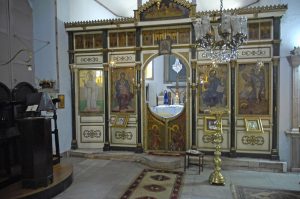
To understand how Simeon got to this point, we should first get a general idea of where the First Bulgarian Empire came from, and how it got very close to uniting the Balkans. The Bulgarians have their roots in Asia, like many Slavic peoples do. The first iteration of the Bulgarians, known as the Bulgars, had staked their claim in modern-day Bulgaria under the rule of their Khans.4 The Bulgar Khans, like the people they ruled over, were tough warriors. A particularly morbid account of one such Khan, Khan Krum, managed to kill the Byzantine Emperor Nicephorus in 811, the first Byzantine Emperor to die in battle for close to five hundred years. Krum then encrusted the deceased Emperor’s skull in silver and used it as a drinking goblet.5
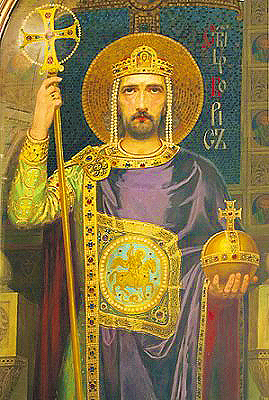
However, the pagan system of Simeon’s ancestors changed, thanks to the efforts of Simeon’s own father, Boris I. Boris I set up the foundations for the first Bulgarian Empire, but his most important action was his conversion to Christianity and his imposing it upon the people of Bulgaria. The reasons for doing so are complex. Part of the reason was to relieve the pressure on Bulgaria from Byzantine armies. But Boris also looked to the world around him in coming to his decision. Most of Europe was turning Christian, with the exception of some Finnish tribes to the far north. In Boris’s mind, if Bulgaria was to be accepted as a modern state, equal to those to the east and west of Europe, it needed to adopt the popular religious practice of the community. Another reason was an underlying fear among those in the Bulgarian Government of a potential conflict between the pagan Proto-Bulgarians and the predominantly Christian Slavs. By converting to Christianity, it was hoped that such a conflict could be prevented, allowing for Bulgaria to remain stable. Whatever the reason, Boris converted to Christianity and imposed this belief on his subjects. This conversion was not without its troubles. Boris feared that by being made part of the Byzantine Church, not only would the Bulgarian traditions not continue, but Byzantium would have an easier time meddling in the governmental affairs of Bulgaria. However, finding no better terms offered by the church in Rome, Boris stuck with the Byzantine church, and in 870, a council regulated the organization of the church in Bulgaria. This was an important step in forming a Bulgarian identity, merging the Proto-Bulgarians and the Slavs into the Bulgarian people we know today. It was also important for Slavic history as a whole, as during this time, the Cyrillic alphabet, first developed around 862 upon request of the ruler of Moravia, was introduced, becoming the language of the state and the Bulgarian church in 893.6
With his four surviving children, out of an initial six, secured in their own lives, Boris abdicated the crown to his son, Vladimir, and retired to a monastery, ending his impact on history. At least, that’s what would have happened. Vladimir, at a first glance, seemed to be the obvious choice for Boris’s heir. He was the oldest surviving son of Boris, and had even served alongside him during Bulgaria’s failed attempt at invading Serbia, in which he was captured and eventually returned at the end of the war. However, Vladimir came to fall under the influence of the old Bulgar aristocracy, the Boyars, which had been effectively diminished by Boris I during his reign. The Court upset all the reforms Boris had made, and devolved into debauchery, even attempting to reintroduce paganism via the defacement and outright destruction of the Christian churches Boris had set up. Vladimir even put to death the Bulgarian archbishop, turning him into a martyr.7 Boris, at first, tried to just ignore this upset, and enjoy his monastic life; but eventually the pressure grew to be too much after four years, and he reemerged. Disappointed that his son worked to undo the progress Bulgaria had made in becoming one of the big players at the European table, he did what any father would do. He dethroned his son, cut out his eyes, and casted him into a dungeon to fade out of history in total darkness and filth, with only the squeaks of rats, the taste of horrible food, and the pain of malnutrition to remind Vladimir that he was still alive. Brutal punishments aside, Boris was now faced with a problem. He was getting too old to rule, so he couldn’t just pick up where his failed son left off. Then, it hit him. He still had another son, Simeon. His younger son was currently living in Constantinople, being prepared for a priestly life of service to God, kind of like what Boris was supposed to be doing. With Simeon brought out of the walled city and to the throne, Boris finally returned to the monastery, for good this time, helping his kingdom no more than with his prayers, leaving behind large boots for Simeon to fill.8
Simeon’s studies in Constantinople gave him not just theological knowledge, but also secular knowledge as well. This love of knowledge continued with him as a desire to spread this knowledge. After all, earlier in 888, he had returned to Bulgaria from Constantinople to pursue Greek studies and to oversee the translation of Greek texts into the Bulgarian language.3 It is no surprise that he continued these efforts once he came to power in 893. He promoted the cause of learning in Bulgaria by further ordering the translation of Greek texts. However, he soon found himself not satisfied with the quality of the translations and thus, took it upon himself to personally translate several Greek texts. These works, along with other educational incentives, laid the foundations for an outpouring of Bulgarian culture over a century later, after the Christian writings had made their course.10 One would be likely to assume, that with Simeon’s education in Greece and his current translation projects, that Simeon would fall easily under the influence of the Byzantines. After all, due to his Greek education, he had gained the nickname of “Half-Argus,” or Half-Greek.11 Despite his “Half-Greek” heritage, however, Simeon did not allow Bulgaria to fall under Byzantine influence. Instead, Simeon hoped to realize the following four points for the Bulgarians: the improvement of national education, the independence and nationalization of the Bulgarian church, the unification and centralization of his empire, and, most ambitious of all, the claim for himself the title of Emperor. Three-fourths of these goals ran in direct opposition to Byzantium’s plans, and Simeon knew this; but he didn’t have the time to stress about making enemies, as he was too busy setting up an empire.12
And build an empire, Simeon did. A very short time into his reign, in 894, conflict began between Bulgaria and Byzantium. The cause of the conflict can be blamed on the thing that has moved humankind for millennia, money. More specifically, the Byzantines transferred the market of Bulgarian goods from Constantinople to Thessalonica, and then burdened the trade with heavy import taxes. The transfer may have been primarily a result of corruption. Quite a few higher-ups in the Byzantine government were in positions that greatly benefited from this ordeal. Simeon, being a scholarly man, tried diplomacy at first. Bulgarian merchants had complained to Simeon about having to travel a much longer and more dangerous road just to sell goods in Byzantium. Simeon sent forward these complaints to the Byzantine Emperor, Leo VI, who dismissed these complaints, much to the disappointment of Simeon. And for this reason, Simeon declared war on Byzantium.13 Immediately on the onset of the war, Simeon invaded Byzantium, gaining much ground. In response, the Byzantines responded with a classic maneuver they had pulled in the past. They marched their armies up north along the coast of the Black Sea. Their navy, meanwhile, sailed up into the mouth of the Danube river, threatening the rear of the Bulgarian army. Then, Byzantium used its gold to bribe the Magyars, a confederation of semi-pastoral people that were located to the north of the Danube, to attack Bulgaria. In response to all of this, Simeon immediately returned back into Bulgaria to defend his people from this onslaught.14 Seeing that Simeon looked to be backed into a corner, Leo VI sent an envoy to the king to settle peace between the two. Simeon, however, was not one to immediately give up when the going gets tough, and he had the envoy imprisoned. Simeon began to quickly survey his options, hoping to find a way out of this corner. Eventually, he found it in another group of pastoral nomads, the Pechenegs, whom he set upon the Magyars. In the spring of 896, the Bulgarians and the Pechenegs launched an expedition against the Magyars into their lands. This expedition was a success, forcing the Magyars into another area of the Danube Basin, where they later evolved into another Eastern European group, the Hungarians.15
With the Magyar threat dealt with, Simeon began to push back against the Byzantium advance, making it into north-eastern Thrace, where he was met by a Byzantine army headed by Leo Katakalon and Theodosius at the village of Boulgarophygon, near Adrianople.16 Here, Simeon thrust his army into the Byzantines, crushing them in a worse defeat than the days of King Krum almost a century earlier. The Byzantine government, sensing that they were defeated, began to negotiate a new peace with the Bulgarians. In this new treaty, not only was the market for Bulgarian goods moved back to Constantinople, not only were the tariffs against those Bulgarian goods lifted, but the Byzantine government was forced to pay tribute to the victorious Simeon, and an uneasy peace descended in the Balkans. Only a little over three years into Simeon’s reign, and already he had made his cannonball dive into the pool of history, sending ripples through the waters we call time, that continues on into our modern world, especially with the settlement of the Hungarians and the arrival of the Pechenegs.17 Simeon, however, was not yet finished. He had seen the glorious heights that Greece had reached in its establishment of Byzantium; after all, he had spent countless hours translating Greek works into Bulgarian, and he wanted those same heights to be reached by the Bulgarians. He wanted to expand the Bulgarian empire across the Balkans, he wanted a Bulgarian church free from Greek influence, he wanted Bulgaria itself to be free of Greek influence and, most of all, he wanted the title of Emperor; but Simeon was in a truce with the Byzantines, and especially after nearly losing the war, Simeon did not want to immediately go back into it and risk destruction. Thankfully, however, Simeon got his chance to secure the title of emperor and, even better, he was to be standing in front of the same city that taught him everything he needed to know, Constantinople.
Until then, Simeon continued to set up his empire. The first place he turned to was to Serbia. Serbia had been a thorn in Bulgaria’s side since before the reign of Boris. In fact, Serbia had united under Prince Vlastimir to drive out the Bulgarian threat over a century earlier. However, like all men, Vlastimir died and followed the Slavic practice of dividing his country up among his sons Mutimir, Strojimir, and Gojnik. Despite Serbia’s “divided” state, it still managed to beat back the invasion of Boris and his son in 853. This war ended in an alliance between the two, which brings the question of why Simeon was looking to control the lands of an ally? Well, the situation in Serbia, from the time of Boris’s attempted retirement, had gone through a massive political change. Mutimir seized control over the other two Serbian states, and exiled his brothers in control of these two to the Bulgarian court. Meanwhile Peter, Gojnik’s Christianized son, had fled to Croatia. When Mutijimir died and his son, Pribislav, came to power, Peter took advantage of the opportunity and after a brief battle, deposed Pribislav in 892 and secured the throne of Serbia. During the first years of his reign, Simeon looked with interest at the little country to his north. He watched as numerous challengers to the throne, even those that were backed by Bulgaria, had failed. Simeon decided to take a different approach to that of his father. Why fight your enemy, when you can “befriend” them and turn them into your puppet? That is exactly what Simeon did in the year 897. Simeon recognized Peter’s reign and Peter placed himself under Simeon’s protection. This twenty-year peace, however, was not favorable to Peter, and the topic of Serbia’s independence came up again.18
The first years of the last century of the millennium were rough for Byzantium. The Emperor at the time, Leo VI was nearing his death bed and thus needed a successor. Unfortunately, the first three wives he married died before giving birth, and already Leo VI was on thin ice, as a third marriage ran contrary to the laws of the Byzantine church. However, he soon found a spark of hope that also sparked more controversy. His mistress, Zoe Karbonospina, gave birth to a son. Leo VI did not pass on the opportunity and married Zoe in January of 906. This sparked controversy, and angered both commoners and clerical staff alike. Especially opposed was Patriarch Nicholas Mystikos who turned Leo away from the church whenever the issue of the marriage was brought up. This led Leo to go to the Pope in Rome to get his marriage legitimized. He then removed Patriarch Nicholas from duty and replaced him with someone more agreeable. In any case, the issue of dynastic succession was resolved, but not in a way favorable to most. In 912, Leo died, leaving his seven-year old son, Constantine, to rule. Well, he didn’t rule yet; instead, his regent and uncle, Alexander ruled in his stead. Now, Alexander was not the best choice for a regent. He was described as an extravagant hedonist, with little knowledge on how to run a government. Indeed, he immediately caused problems with Simeon I. When Simeon sent envoys to Constantinople to collect some of the tribute promised in the 896 treaty, Alexander turned them away, calling them, and by extension Simeon, savages that had disguised themselves with the skins of civilization. Simeon did not take this insult lightly, and once again began an invasion of Byzantium. During this already chaotic time, Byzantium suffered another event that further threw them into chaos. Alexander suddenly died and the factional divisions that emerged with Leo’s marriage to mistress Zoe came back into the forefront. A council of regency was set up with Nicholas Mystikos, whom Alexander had restored during his brief reign, as its head. It was quite ironic that Nicholas was now forced to help a king, whom he himself didn’t recognize as legitimate, to secure his place on the throne. To make matters worse, Constantine Dukas, commander of the Byzantine central army, took advantage of the chaos and made his own claim to the throne.19
Between teaching a young boy how to rule, dealing with the threat of a rebellion in the capital, and facing a full-on invasion by the Bulgarians, Nicholas was in a stressful position. Nicholas, knowing that he couldn’t hope to face Simeon in battle, swallowed his pride and began to write letters to Simeon. In these letters, Nicholas tried everything he could think of to dissuade Simeon from continuing his invasion, from begging Simeon to take mercy on the young child who was now king, to offering the tribute payments; but none could dissuade the invader. Simeon was not about to let this golden opportunity pass him by. Soon enough, Simeon reached the walls of Constantinople.20 Simeon, being well educated in Byzantine culture, figured that he didn’t have to invade the city to get his demands met, especially given how pleading the letters he received from the Patriarch were. Nicholas Mystikos, upon seeing the Bulgar outside of the city of Constantinople, knew the writing was on the wall. However, he also saw Theodore step into the city and say that Simeon was open to negotiations. A wave of relief almost drowned Nicholas, and soon enough, he invited Simeon into the city, where he crowned Simeon I the Emperor of the Bulgarians and the Byzantines. The legitimacy of this is very questionable. Most likely, this was just Nicholas giving him the right to call himself Basil, or emperor, of his lands. While this was a rare honor indeed, Nicholas probably wasn’t in the position to do so. Most likely, this was just an attempt to get Simeon to leave. Simeon probably knew this, but figured that, with the hand of his daughter secured in marriage to the young Constantine, he would be able to actually legitimize himself. However, the regency council wasn’t very stable and by extension, neither was Simeon’s title. In fact, Nicholas soon found himself overthrown by a palace coup before the summer was out. In his place, a new regency council was established, and at the head was none other than mistress Zoe. Immediately, she forbade the marriage between her son and one of Simeon’s daughters and declared Simeon’s title of emperor invalid. At this point, Simeon was furious. He wasn’t about to let some illegitimate empress refute his own slightly illegitimate emperorship. The wisdom of his youth had left him; no longer was he the man who helped secure Bulgarian culture; no longer was he the man who kept his enemies at bay, capitalizing on opportunities that arose from the failures of his enemies. Now, he was very much like the warlords that were his ancestors. His armies throughout the following years, raided areas of the Byzantine countryside building up tensions between the two empires. Simeon, however, was not to be satisfied with the suspiciously pagan style of raiding. His ambition had fully overtaken him and forced out his wisdom. Simeon was now the man, no, the Tsar, who was responsible for one of the largest and bloodiest battles of medieval history.21
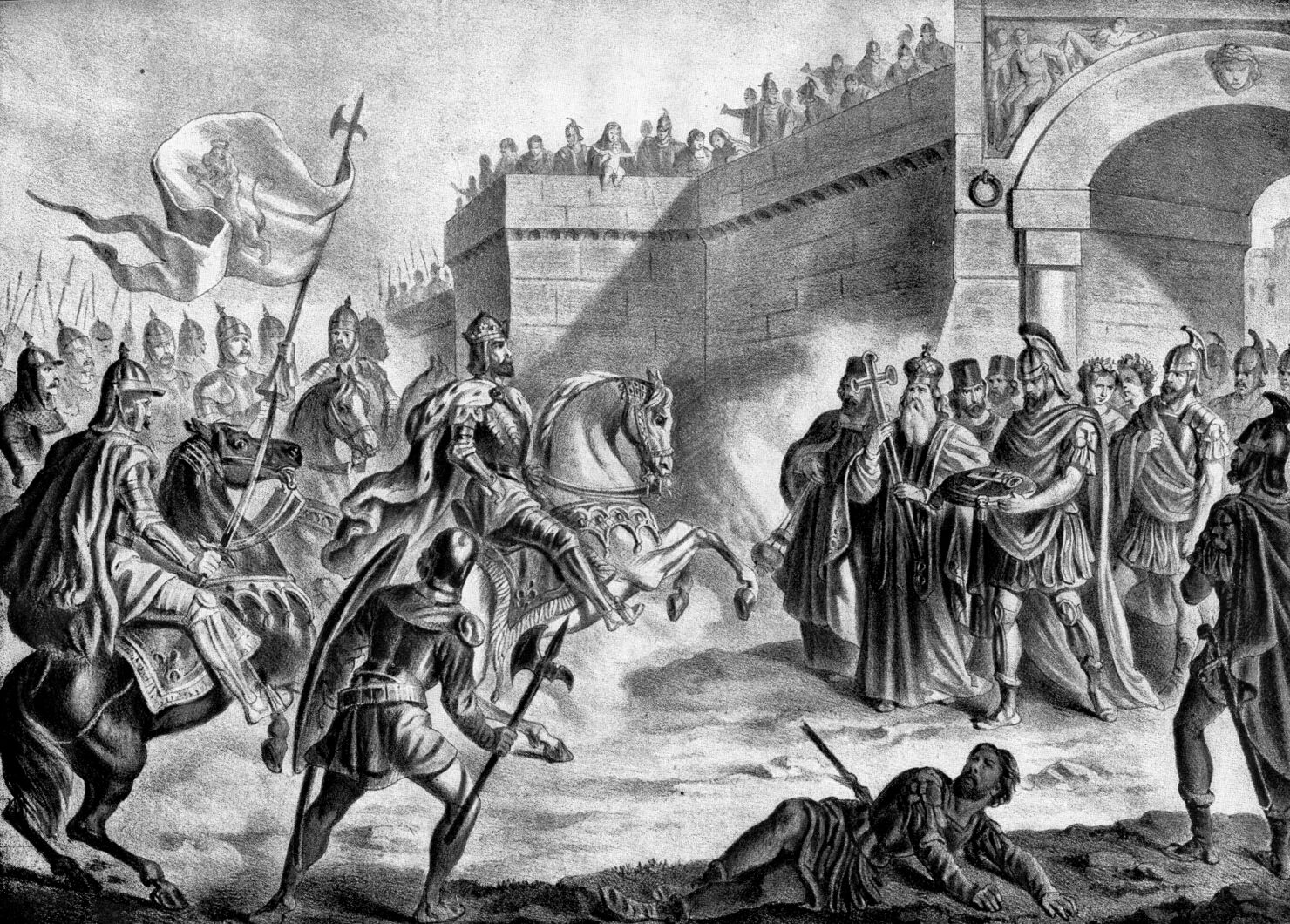
Through the aforementioned Pagan-styled raids, Simeon had managed to secure Adrianople in the year 914. Through this, Simeon also pushed the boundaries of the Bulgarian Empire to the Adriatic Sea.22 Eventually, however, Adrianople was returned, thanks to the payment of gold and many gifts.23 Three years later, in August of 917, the Byzantine Empire, under Zoe, invaded Bulgaria through the south, in a large counterattack headed by Leo Phocas, with support from the Byzantine navy headed by Romanus Lekapenos. The invasion was justified under the claim that the Bulgarians were negotiating with the Pechenegs, which was very problematic, given how the Pechenegs were pagan and the Bulgarians were Christian. The reason they came to this conclusion might have something to do with the war with Simeon almost thirty years ago. The complaint of Bulgarian alliance was ironic, especially given the Byzantine alliance with the Pechenegs in this war. Despite their new alliance, however, the Pechenegs had a sense that this was a foolish endeavor on the part of Byzantium. They saw that the two generals in charge of the invasion, Leo Phocas and Romanus Lekapenos, had an intense jealously of each other, and both lacked loyalty to Zoe, seeking to secure the regency for themselves. The Pechenegs backed out, leaving Byzantium to face Bulgaria alone.24 The Byzantines had landed themselves on the banks of the river Achelous. Simeon, who had only very recently been informed of the gathering, had situated himself on a series of hills overlooking the coastal plain where the Byzantines had situated themselves. Looking down from the hills, Simeon could see the large Greek force he had to face. This was not just any force, but an especially dangerous one. Known as the tagmata, or the regiments, the small elite force was established by Emperor Constantine V, and was made up of some of the best soldiers hand picked from the Byzantine army.25 Supporting the well-renowned regiment were several divisions taken from Asia Minor and brought across to Bulgaria. When combined with the armies of Thrace and Macedonia, the army Simeon was facing numbered around 30,000 men. While not officially recognized as a rival Emperor, Simeon certainly was being treated as one. Soon enough, Simeon gave the order to begin the attack. A flurry of screams, clashing of iron, and cries in agony soon rang out across the plain as the two empires clashed. Blood coated the region in a fine red dress as bodies collapsed onto the ground, mangled and torn. As the battle raged on, Simeon’s Bulgarian force began to shrink as his soldiers died in pain. The Byzantine army pressed forward into the Bulgarians, pushing them farther and farther back, every inch indicating the deaths of several good men. Simeon could see that the battle was beginning to go poorly and ordered his forces to fall back to a more defensible position. Leo Phocas, seeing this, decided to take a rest. Coming upon a stream, he dismounted from his horse and started to drink from the cool, refreshing water. Unfortunately for him, his horse didn’t join him. Frightened by something, the horse bolted back into battle. The soldiers, seeing Phocas’s riderless horse, assumed the worst, that Leo Phocas, their commander, was dead. As word spread through the army, they began to raise debates as to whether they should retreat or continue their advance. If they were to continue their advance, who was to lead them? Soon, confusion gave way to panic, especially ironic given the Byzantine’s current position of authority. Seeing the confusion and disorder among their ranks, Simeon ordered his withdrawing forces to halt and take advantage of the new opportunity that had presented itself. The Bulgarian army charged into the confused Byzantine force, slaughtering many important officers in the army along with their men further feeding into the Byzantine panic and disorganization. The defeat at Achelous was one of the worst suffered by Byzantium in one hundred years, along with being one of the bloodiest battles in the middle ages.26 According to reports decades after the fact, piles of bones could still be seen dotting the Achelous river where they were killed.27
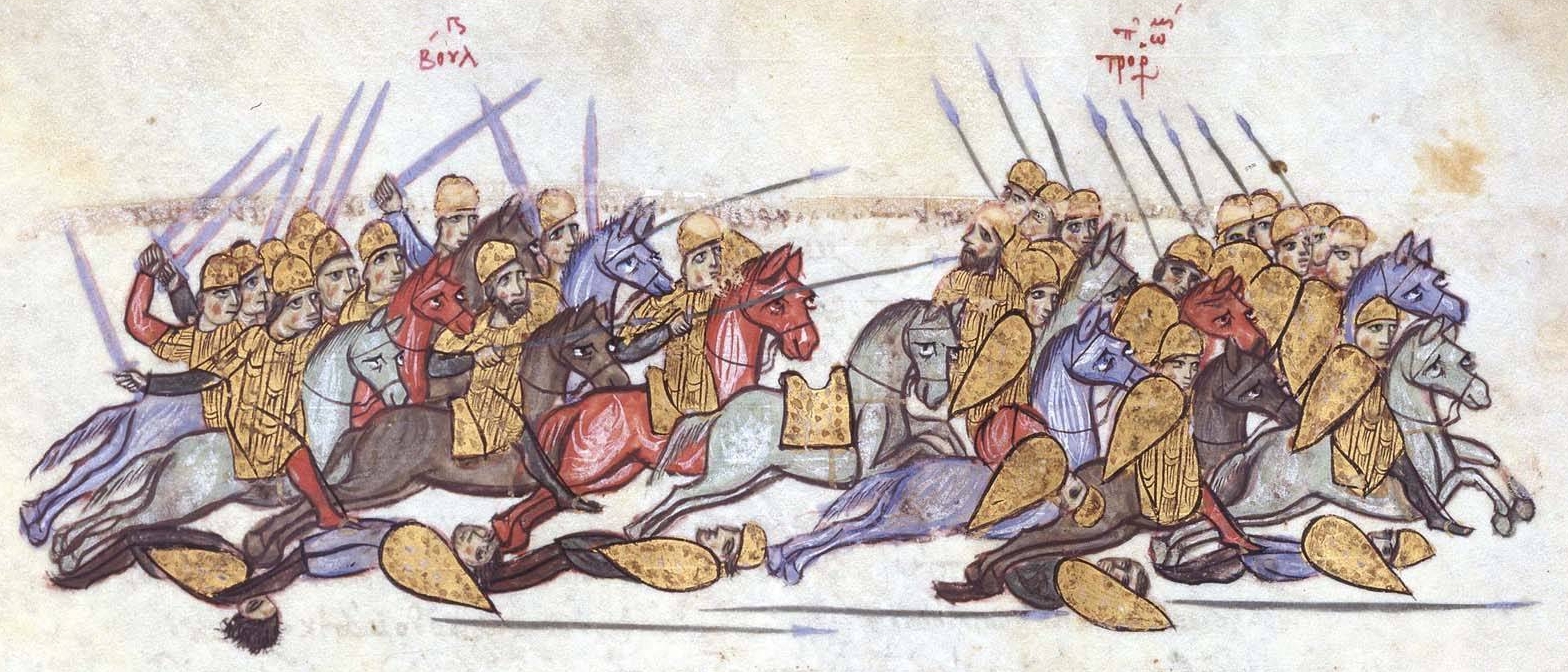
The defeat of the Byzantines at Achelous opened up the Balkan Peninsula for Bulgarian military exercises. Simeon did not let this opportunity pass, and plunged his army deep into Byzantine lands, further discrediting Zoe as a capable leader who could protect her people.28 Nicholas once again attempted to convince Simeon to stop his invasion, writing letters in which he explained the reasoning behind the Byzantine invasion and to justify Simeon’s victory at Achelous in a religious context. Essentially, according to the patriarch, Simeon was able to win because God was with him and had left the Byzantines due to their sins. Furthermore, if Simeon, instead of turning back and forgiving the Byzantines of their sins, continued to invade Byzantium, he would be punished by God.29 Simeon was undeterred; only being declared Emperor could satisfy him, something that neither Nicholas, nor Zoe was able, or willing, to offer. Zoe had another trick up her sleeve. She sent an embassy to Serbia with instructions to meet with Serbia’s court and inform them of the dangers of a large Bulgaria. Recognizing the danger, Peter, the king of Serbia, agreed to the alliance with Constantinople and was resolved to punch into the rear of the Bulgarian lands. Simeon, however, soon caught wind of this and decided to strike first. His generals invaded Serbia and by 918, seized control of the country.30 Peter was imprisoned in Bulgaria after being deposed, where he died within a year. In his stead, Simeon placed Pavel, son of Bran Mutimirovic who led a failed rebellion against Peter in 894, on the throne.31 With the Serbian matter settled, Simeon looked back to Constantinople only to find out that there had been another window of opportunity that he had missed, which had since closed. The admiral of the Byzantine fleet, Romanus Lekapenos, had seized control of the chaotic situation in Constantinople, deposing regent Zoe in a palace coup. To tie himself into the royal family, he had his daughter, Helena, marry the fourteen year old Emperor Constantine, promoting himself to the rank of Caesar and becoming Co-emperor for his son in law. Simeon was understandably furious. Despite the victories he had achieved at Achelous, he still wasn’t crowned Emperor. The Bulgarians began to build up their military pressure on the Byzantines, in the hope that such actions would convince Romanus to abdicate his title. Romanus wasn’t budging. The Armenian had clawed his way to the top, and he wasn’t about to let some savage decide his fate.32 Nicholas Mystikos, on his part, tried to mediate the conflict between the usurper and the Bulgarian. After all, Simeon himself said that he wasn’t demanding the impossible, like the resurrection of the Bulgarian dead, but just for Romanus to abdicate. Nicholas knew that this in itself was not probable, if not impossible, to occur, so instead he tried offering gifts to try and placate the Bulgarian, like Zoe did before. However, Simeon was old now, and he knew that there probably wasn’t much he could do with gifts of gold or clothing, or even a small slice of territory. Romanus on his part wasn’t completely against negotiation as he offered up another one of his daughters to one of Simeon’s descendants, but this didn’t work, as it wasn’t the marriage Simeon desired.33 To cause more trouble for the Bulgarians and prevent an invasion by proxy, Romanus sent Serbian Prince Zacharias to stir up trouble in the Serbian puppet state. Zacharias failed to overthrow Paval, and was imprisoned in Bulgaria, to be used against Pavel if he tried to resist Bulgaria’s will. 34 Simeon tried again and again to dethrone Romanus throughout the early years of the 920s, but each time, despite how far he got into Greek territory, he wasn’t able to breach the walls of Constantinople. His attempts to offer the Fatimids of Egypt an alliance in exchange for Byzantine territory failed as the Byzantines were able to beat Simeon’s promises with cash.32 In 921, at Catasyrtae, Simeon marched to Constantinople, but a Greek army managed to push him back out. In 922, during an occupation of Thrace after a successful raid, his armies were pushed out of their camps by a Greek counterattack. Just a year later, in 923, he occupied Adrianople, taking out his frustration on its governor, by brutally torturing him to death, but troubles in Serbia prompted Simeon to return to his lands.36 This upset, in turn, prompted Simeon to annex Serbia completely. In the end, Simeon was never able to fully crown himself Emperor of the Byzantines and the Bulgarians. Soon after his failure in attempts to annex Croatia, Simeon the Great died in 927, and while his son, Peter, was described as a man of great Christian piety, he was unfit to rule, and through a series of events, the First Bulgarian Empire came to an end, being annexed by Byzantium, which was, in turn, annexed by the Ottoman Turks.37
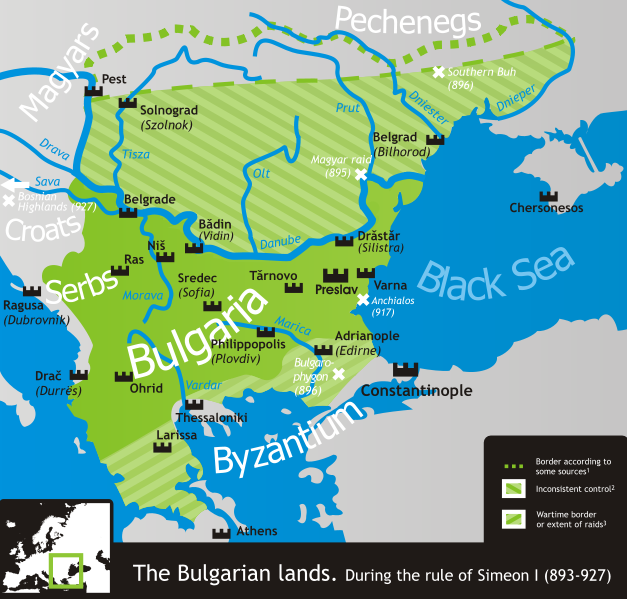
Despite his failures, Simeon the Great was perhaps one of the most, if not the most, important Bulgarian rulers in history. Having almost entirely united the Balkan peninsula, Simeon was able to harass the Empire of the Byzantines for years. He had secured Christianity’s place in Bulgaria, against the influences of pagan worshipers, and even secured the independence of its church. He had helped the capital of Preslav flourish, which in turn further freed Bulgaria from its Pagan past.3 Most importantly of all, under Simeon the Great, Bulgaria was able to become Bulgaria. While he didn’t live to see it, his educational efforts and translations helped push the Bulgarians to develop their own culture and literature, one almost entirely independent from the Greeks. However, one cannot look at the First Bulgarian Empire without a sense of the missed opportunity. Had the Byzantine’s and the Bulgarian’s managed to overcome their differences, they could have more effectively fought off attacks from Asia and Europe, changing the course of European history for the next thousand years. While it’s more the responsibility of the fiction writer to speculate on an alternative world, the ramifications of such a change should be apparent to all. 39 In the end, however, while Simeon’s First Bulgarian Empire did not last long after his death, his legacy still lives on today.
I’d like to thank Dr. Whitener for working with me on my topic so that it reached its full potential. Without him, this article wouldn’t be the quality it is right now. I would also like to thank both of my tutors for helping me in different stages of my article. The first tutor being Amanda Uribe, who helped me in my initial search for sources to use in my article. The second tutor being Christopher Hohman, who got my project proposal to the place it needed to be. I would also like to thank Dr. Root who gave me advice as to where to find further sources, and who gave me the idea to take some sources from the Byzantine perspective to round out the entire story. I would also like to thank the consultation of librarian Diane M. Duesterhoft for helping me to find further sources as well. Finally, I would like to thank you, the person reading this, for taking a chance on such a niche topic that my article covers.
- Steven Runciman, A History of the First Bulgarian Empire – Book III The Two Eagles, (London: G. Bell & Sons, 1930), 156-157, http://macedonia.kroraina.com/en/sr/sr_3_1.htm. ↵
- Robert Browning, “The Golden Age of Byzantium 867–1081,” in The Byzantine Empire (Revised Edition) (Catholic University of America Press, 1992), 103-104, https://doi.org/10.2307/j.ctt284zf4.9. ↵
- Gloria Fulton, “Bulgaria’s Golden Age,” in Salem Press Encyclopedia (Salem Press, 2020). ↵
- Ferdinand Schevill, The History of the Balkan Peninsula: From the Earliest Times to the Present Day (Harcourt, Brace and Company, 1922), 92. ↵
- R. J. Crampton, A Concise History of Bulgaria (Cambridge University Press, 2005), 33-34. ↵
- R. J. Crampton, A Concise History of Bulgaria (Cambridge University Press, 2005), 37-39. ↵
- John V. A. Fine, The Early Medieval Balkans: A Critical Survey from the Sixth to the Late Twelfth Century (Ann Arbor: University of Michigan Press, 1983), 130, https://catalog.hathitrust.org/Record/000233831. ↵
- Steven Runciman, A History of the First Bulgarian Empire – Book III The Two Eagles (London: G. Bell & Sons, 1930), 134-136, http://macedonia.kroraina.com/en/sr/sr_3_1.htm. ↵
- Gloria Fulton, “Bulgaria’s Golden Age,” in Salem Press Encyclopedia (Salem Press, 2020). ↵
- Ferdinand Schevill, The History of the Balkan Peninsula: From the Earliest Times to the Present Day (Harcourt, Brace and Company, 1922), 99-100. ↵
- Steven Runciman, S. Runciman – A History of the First Bulgarian Empire – Book III The Two Eagles (London: G. Bell & Sons, 1930), 137, http://macedonia.kroraina.com/en/sr/sr_3_1.htm. ↵
- Stephen S. Bobčev, “Bulgaria under Tsar Simeon,” The Slavonic and East European Review 7, no. 21 (1929): 624–25. ↵
- Mirosław J. Leszka and Katarzyna Gucio, “The Monk versus the Philosopher: From the History of the Bulgarian-Byzantine War 894-896,” Studia Ceranea. Journal of the Waldemar Ceran Research Centre for the History and Culture of the Mediterranean Area and South-East Europe 1 (December 30, 2011): 58–60, https://doi.org/10.18778/2084-140X.01.04. ↵
- Robert Browning, “The Golden Age of Byzantium 867–1081,” in The Byzantine Empire (Revised Edition) (Catholic University of America Press, 1992), 100–101, https://doi.org/10.2307/j.ctt284zf4.9. ↵
- Mirosław J. Leszka and Katarzyna Gucio, “The Monk versus the Philosopher: From the History of the Bulgarian-Byzantine War 894-896,” Studia Ceranea. Journal of the Waldemar Ceran Research Centre for the History and Culture of the Mediterranean Area and South-East Europe 1 (December 30, 2011): 64, https://doi.org/10.18778/2084-140X.01.04. ↵
- Mirosław J. Leszka and Katarzyna Gucio, “The Monk versus the Philosopher: From the History of the Bulgarian-Byzantine War 894-896,” Studia Ceranea. Journal of the Waldemar Ceran Research Centre for the History and Culture of the Mediterranean Area and South-East Europe 1 (December 30, 2011): 69, https://doi.org/10.18778/2084-140X.01.04. ↵
- Robert Browning, “The Golden Age of Byzantium 867–1081,” in The Byzantine Empire (Revised Edition) (Catholic University of America Press, 1992), 100-101, https://doi.org/10.2307/j.ctt284zf4.9. ↵
- John V. A. Fine, The Early Medieval Balkans: A Critical Survey from the Sixth to the Late Twelfth Century (Ann Arbor: University of Michigan Press, 1983), 141-142, https://catalog.hathitrust.org/Record/000233831. ↵
- Robert Browning, “The Golden Age of Byzantium 867–1081,” in The Byzantine Empire (Revised Edition) (Catholic University of America Press, 1992), 102–103, https://doi.org/10.2307/j.ctt284zf4.9. ↵
- Steven Runciman, S. Runciman – A History of the First Bulgarian Empire – Book III The Two Eagles (London: G. Bell & Sons, 1930), 156-157, http://macedonia.kroraina.com/en/sr/sr_3_1.htm. ↵
- Robert Browning, “The Golden Age of Byzantium 867–1081,” in The Byzantine Empire (Revised Edition) (Catholic University of America Press, 1992), 103–104, https://doi.org/10.2307/j.ctt284zf4.9. ↵
- Robert Browning, “The Golden Age of Byzantium 867–1081,” in The Byzantine Empire (Revised Edition) (Catholic University of America Press, 1992), 104–105, https://doi.org/10.2307/j.ctt284zf4.9. ↵
- John Skylitzes and John Wortley, John Skylitzes: A Synopsis of Byzantine History, 811–1057: Translation and Notes (Cambridge University Press, 2010), 230. ↵
- John V. A. Fine, The Early Medieval Balkans: A Critical Survey from the Sixth to the Late Twelfth Century (Ann Arbor: University of Michigan Press, 1983), 149, https://catalog.hathitrust.org/Record/000233831. ↵
- John Haldon, Byzantine Wars (The History Press, 2008), 56. ↵
- John Haldon, Byzantine Wars (The History Press, 2008), 72-74. ↵
- Leo the Deacon, The History of Leo the Deacon: Byzantine Military Expansion in the Tenth Century, trans. Dennis Sullivan and Alice-Mary Talbot (Washington D.C: Dumbarton Oaks Reaserch Library and Collection, n.d.), 171. ↵
- Robert Browning, “The Golden Age of Byzantium 867–1081,” in The Byzantine Empire (Revised Edition) (Catholic University of America Press, 1992), 105–106, https://doi.org/10.2307/j.ctt284zf4.9. ↵
- John V. A. Fine, The Early Medieval Balkans: A Critical Survey from the Sixth to the Late Twelfth Century (Ann Arbor: University of Michigan Press, 1983), 150, https://catalog.hathitrust.org/Record/000233831. ↵
- Steven Runciman, A History of the First Bulgarian Empire – Book III The Two Eagles (London: G. Bell & Sons, 1930), 162-163, http://macedonia.kroraina.com/en/sr/sr_3_1.htm. ↵
- John V. A. Fine, The Early Medieval Balkans: A Critical Survey from the Sixth to the Late Twelfth Century (Ann Arbor: University of Michigan Press, 1983), 150, https://catalog.hathitrust.org/Record/000233831. ↵
- Robert Browning, “The Golden Age of Byzantium 867–1081,” in The Byzantine Empire (Revised Edition) (Catholic University of America Press, 1992), 106, https://doi.org/10.2307/j.ctt284zf4.9. ↵
- John V. A. Fine, The Early Medieval Balkans: A Critical Survey from the Sixth to the Late Twelfth Century (Ann Arbor: University of Michigan Press, 1983), 151, https://catalog.hathitrust.org/Record/000233831. ↵
- Steven Runciman, A History of the First Bulgarian Empire – Book III The Two Eagles (London: G. Bell & Sons, 1930), 165, http://macedonia.kroraina.com/en/sr/sr_3_1.htm. ↵
- Robert Browning, “The Golden Age of Byzantium 867–1081,” in The Byzantine Empire (Revised Edition) (Catholic University of America Press, 1992), 106, https://doi.org/10.2307/j.ctt284zf4.9. ↵
- Steven Runciman, A History of the First Bulgarian Empire – Book III The Two Eagles (London: G. Bell & Sons, 1930), 165-166, http://macedonia.kroraina.com/en/sr/sr_3_1.htm. ↵
- Ferdinand Schevill, The History of the Balkan Peninsula: From the Earliest Times to the Present Day (Harcourt, Brace and Company, 1922), 103-104. ↵
- Gloria Fulton, “Bulgaria’s Golden Age,” in Salem Press Encyclopedia (Salem Press, 2020). ↵
- Robert Browning, “The Golden Age of Byzantium 867–1081,” in The Byzantine Empire (Revised Edition) (Catholic University of America Press, 1992), 105, https://doi.org/10.2307/j.ctt284zf4.9. ↵

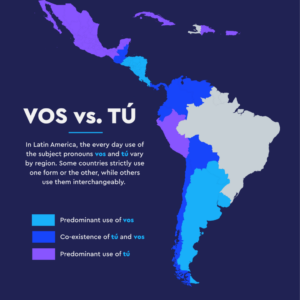

7 comments
Stoyan Deckoff
As a Bulgarian, I was searching for article in English to send to a friend. I find it well written and interesting, though I know most of the facts
What I think should be more detailed, is the important role of Simeon for creating the Bulgarian alphabet and early literature, that serves as a stepping stone for Slavic Culture even now. Mind it producing 1000s of book back then, without a printing press required quite the money and organizational effort – Build monastaries, teach monks provide animals for that would be required for the pages of the books and feed the monks that copy the books. Not only that, but through political maneuvers he forced the other Patriachs to recognize the independence of the Bulgarian one, creating a new center of Christian seat AND defending the right Bulgarian ( and Slavic) lanaguge to be canonical alongside with the then only recognized greek latin and israeli.
Santos Mencio
An interesting article, I was aware that a Bulgarian empire had formed around that time but hadn’t really been aware of how it came to be. Simeon was clearly a competent ruler, that was able to find a great many ways to combat his foes and achieve his goals. While he was ultimately unsuccessful in conquering Constantinople, he certainly left a lasting mark on the Balkans and their peoples.
Jaedean Leija
Greek history is always fun to hear or read about if told the right way. Great article very festinated and as I was reading I had questions but in some way it was like you knew what people will question and you answered it all in one article. I really think you should consider being a professional writing , y you have incredible writing skills and I feel like more people should be able to appreciate them.
Christopher Metta Bexar
I don’t think Trenton writes niche articles. I think he writes articles on topics many are not willing to discuss, and many need to read about.
I know the article is likely long, but like his article on Timothy Dexter it continues to bring the reader along, bringing them to the places needed to bring them to the finish. I don’t usually find articles about eastern European history all that interesting, but this one has enough storytelling to keep the reader going along and learning.
Matthew Gallardo
This article was absolutely amazing. Beforehand, I did know that the nation of bulgaria was alive and thriving at the same time as the Byzantine empire, but I had no idea of their power and influence over the Balkans, winning multiple battles against the Byzantine empire, which was a very powerful nation. No wonder they survived during the Byzantine era.
Elliot Avigael
The Bulgarians are an extremely underrated group of European barbarians. I think the ferociousness of the Vikings, Visigoths, and Slavs overshadows just how terrifying and formidable of a tribe the Bulgarians were.
It’s interesting how Bulgaria’s conversion to Christianity didn’t seem to ease any tensions with the Byzantines at all.
Heather
Wow! Another well written article. I am not one to seek out history articles but yours are well written and keep me engaged.